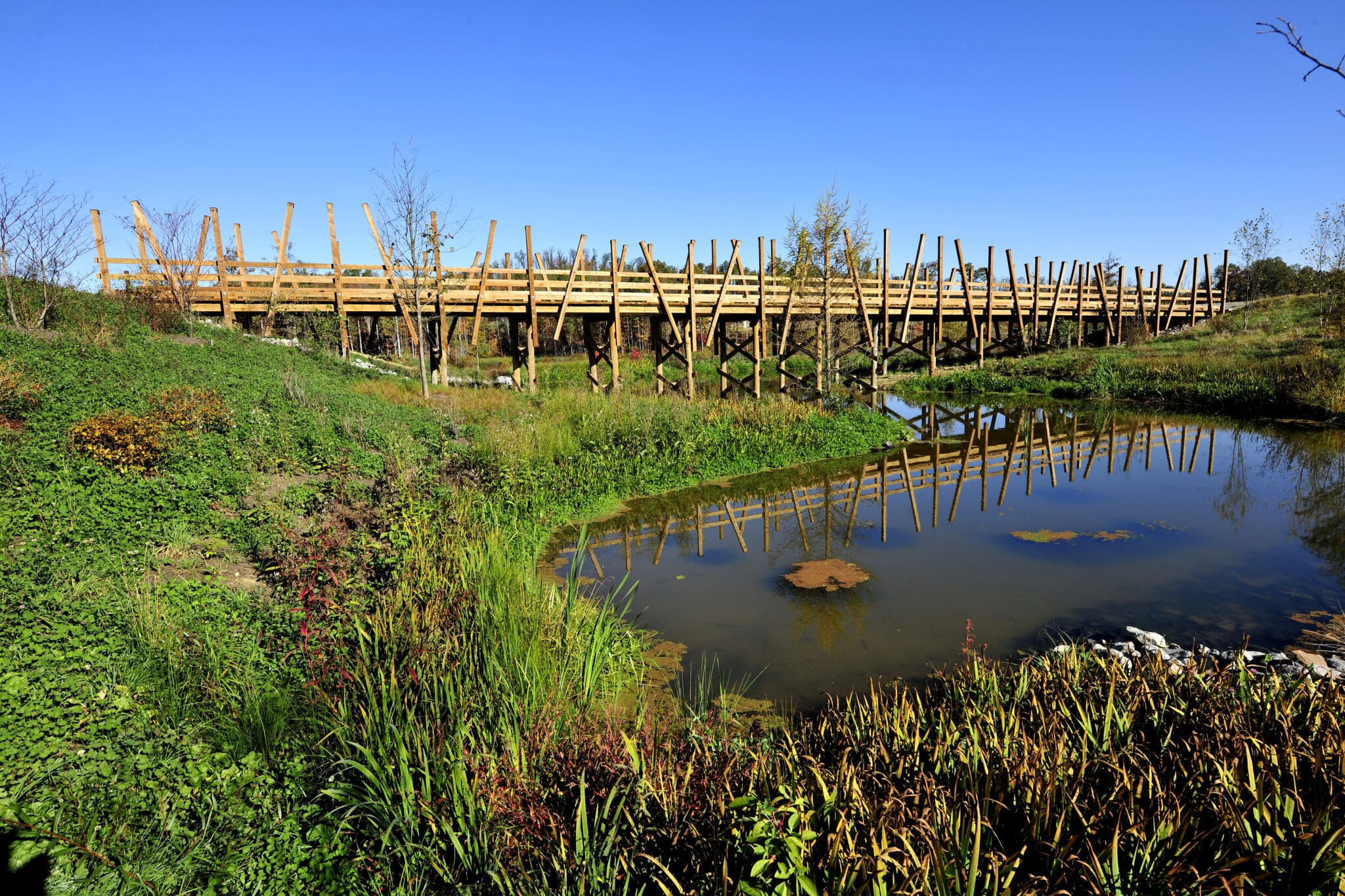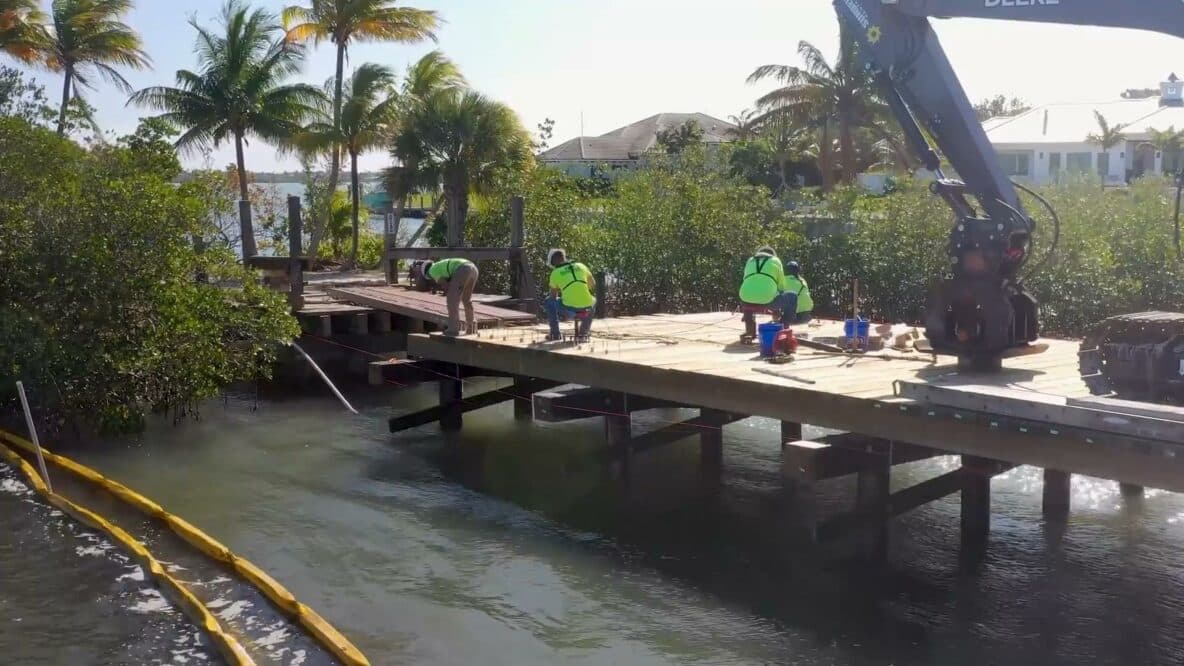Overcoming Wetland Construction Challenges: Limited Access, Soft Soil & Flooding Risks
Wetlands provide crucial environmental benefits, including water filtration, habitat conservation, and flood mitigation. However, constructing infrastructure in these sensitive ecosystems presents unique challenges. Wetland projects, such as bridges, boardwalks, and trails must address limited site access, unstable soil conditions, and flood risks while adhering to stringent environmental regulations.
York Bridge Concepts (YBC) specializes in top-down timber bridge construction, an approach that minimizes ground disturbance and ensures sustainable infrastructure development. This article explores the challenges of wetland construction and the innovative methods used to overcome them, including regulatory considerations and real-world case studies.
Challenges of wetland construction
Limited Site Access
Wetlands often lack existing roadways or stable ground to support heavy construction equipment. Traditional infrastructure projects require temporary roads or large staging areas, which can lead to habitat destruction and soil compaction (EPA, 2021).
Solutions:
- Deck-Level (top-down) Construction: YBC's method builds from above, eliminating the need for temporary access roads (USDA Forest Service, 2020).
- Handmade Timber Components: These allow for rapid assembly with minimal site disturbance.
- Lightweight Equipment: Reducing the need for heavy machinery prevents unnecessary wetland damage (USACE, 2021).
Soft, Unstable Soils
Wetland soils are saturated, organic-rich, and prone to shifting, making them unsuitable for conventional foundation techniques (USGS, 2023). Traditional concrete and steel structures require deep pile foundations, which can alter the hydrology of the area.
Solutions:
- Timber Piling Foundations: Lighter than steel or concrete, timber piles distribute weight effectively without excessive soil disturbance (American Wood Council, 2021).
- Multiple Spans: Multiple spans can use free-spans in combination with pilings to create less piling foundations in the wetlands and increase hydrologic flow.
Flooding Risks
Wetlands are naturally prone to seasonal flooding and fluctuating water levels, requiring infrastructure that can withstand extreme weather conditions and prolonged submersion.
Solutions:
- Elevated Bridge & Boardwalk Designs: Raised timber structures minimize contact with floodwaters (USACE, 2022).
- Pressure-Treated Timber: Ensures longevity and resistance to moisture damage (Forest Stewardship Council, 2022).
- Hydrodynamic Modeling: Predicts water flow and helps engineers design flood-resilient infrastructure (EPA, 2022).
Regulatory Considerations
Wetland projects must comply with various environmental laws and permitting requirements, including:
- Clean Water Act (CWA) & Section 404 Permits
- Regulates the discharge of materials into wetlands and requires permits for construction activities (EPA, 2021).
- YBC collaborates with U.S. Army Corps of Engineers (USACE) to ensure permit approval and compliance (USACE, 2021).
- North American Wetlands Conservation Act (NAWCA)
- Provides funding for wetland conservation projects that support habitat protection and sustainable infrastructure (USFWS, 2022).
- Timber bridge projects that align with NAWCA goals can receive federal grants and approval benefits.
- State & Local Wetland Regulations
- Many states enforce additional buffer zones and mitigation plans to protect wetland integrity (National Wetlands Inventory, 2023).
- YBC integrates eco-friendly construction materials and methods to meet stat and local standards (USDA, 2021).

Case Study: Timber Boardwalks & Bridges In West Virginia Wetlands
Summit Bechtel Reserve, Glen Jean, WV
YBC successfully implemented three HS20-44 vehicular timber bridges, seven pedestrian bridges, and an expansive boardwalk system that spans the 10,600-acre property through protected wetlands for the Scouts of America outdoor adventure and conservation center.
Key Features:
- Deck-Level Construction to avoid ground disturbance for projects in protected areas.
- Pressure-Treated Timber for enhanced durability in high-moisture environments
- Compliance with NAWCA & USACE Permits to ensure regulatory adherence.
The result was a low-impact, resilient structure that balanced conservation with accessibility, setting a benchmark for wetland infrastructure projects.
Support in Wetland Construction
Wetland construction requires innovative solutions to address limited access, unstable soils, and flood risks while ensuring compliance with strict environmental regulations. Timber bridges and boardwalks, particularly those built using YBC's top-down construction method, offer a sustainable, cost-effective, and resilient alternative to traditional infrastructure.
By integrating environmentally friendly materials, strategic design, and compliance with wetland protection laws, timber-based wetland infrastructrue can support both ecological preservation and public accessibility for generations to come.
American Wood Council. (2021). Timber foundations in wetland environments. Retrieved from https://www.awc.org/
Environmental Protection Agency (EPA). (2021). Wetland construction regulations and Section 404 permitting. Retrieved from https://www.epa.gov/wetlands
Federal Emergency Management Agency (FEMA). (2022). Floodplain management strategies. Retrieved from https://www.fema.gov/floodplain-management
Forest Stewardship Council (FSC). (2022). Sustainable timber treatments for wetland structures. Retrieved from https://www.fsc.org/
National Park Service. (2022). Sustainable boardwalk construction in protected environments. Retrieved from https://www.nps.gov/
National Wetlands Inventory. (2023). State and local wetland regulatory frameworks. Retrieved from https://www.fws.gov/wetlands/
North American Wetlands Conservation Act (NAWCA). (2022). Wetland conservation funding programs. Retrieved from https://www.fws.gov/law/north-american-wetlands-conservation-act
United States Army Corps of Engineers (USACE). (2022). Wetland infrastructure permitting requirements. Retrieved from https://www.usace.army.mil/
United States Department of Agriculture (USDA) Forest Service. (2021). Timber engineering for flood-prone environments. Retrieved from https://www.fs.usda.gov/
United States Geological Survey (USGS). (2023). Climate impact assessments on wetland infrastructure. Retrieved from https://www.usgs.gov/
United States Fish and Wildlife Service (USFWS). (2022). Conservation guidelines for wetland infrastructure. Retrieved from https://www.fws.gov/
York Bridge Concepts (YBC). (2023). Sustainable timber boardwalks in wetland environments.
Create Your Legacy Today
Discover the intersection of strength, durability, and environmental responsibility with York Bridge Concepts. Let's build a bridge to the future together.

